Garden City GC
NY, USA
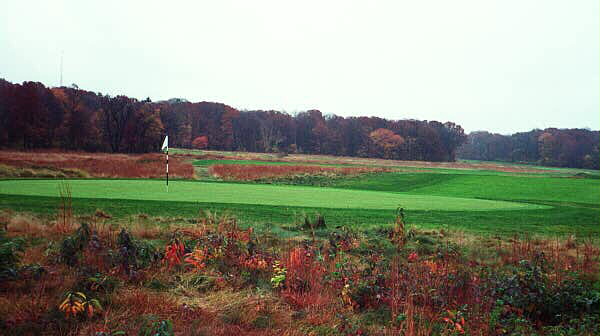
The open expanse of the Hempstead Plain as pictured in November from behind the 6th green.
There is no other course in the world quite likethe course at Garden City Golf Club.
Some first time visitors are tempted to call it a links because of the sandy loam soil, its deep bunkers, and the wind. However, the Atlantic Ocean is a good tenmiles away and if you go to any of the surrounding courses, the soil is much heavier. No, this land was never truly a links even if it does possess many of its characteristics.
Some American golfers also try to compareGarden Cityto England’s finest heathland courses. After all, once you are on the Hempstead Plain, the same feeling of openness and expansiveness that makes heathland courses so invigorating is readily evident. But alas, there is no heath here, so such comparisonscarry little worth.
Garden City is a true original. Perhaps the closest course in the United States would be the Myopia Hunt Club, and with good reason: the original nine holes of each course wereopened within one year of each other.
Similar to H.C. Leeds, Devereux Emmet was a man of leisure who enjoyed his annual trips to Europe where he studied many of the famous holes and courses. When given the chance to design a course for Garden City, he madefine useof the opportunity and his general routingaccounts for much of Garden City’s appeal to this day.
Garden City quickly hosted the 1902 U.S. Open, where it met with praise fromits participants, including one Donald Ross. No more than two holes went in the same direction, many of the greens were open in front, andgiven the firm turf thanks to the sandy soil, the participants from both sides of the Ocean enjoyed keeping the balllow out of the wind by playing low running shots onto the greens.
Like Leeds, Emmetutilized cross bunkers to present a direct challenge to the golfer. However, unlike Leeds, Emmet didn’tinstillthe greens with much contour nor did he make his bunkers particularly penal – escape was easy.
Enter the Grand Old Man – Walter Travis. Already amember of Garden City, and the runner-up in the 1902 U.S. Open, he was also a student of golf course architecture and later founded The American Golfer magazine, which he used to freely criticize the general direction of architecture in the United States.
In particular, Travis despised the blandness of American golf and wrote, ‘Golf, with us, is mostly of a kindergarten order. The holes are too easy and there is too much of a family resemblance all through.’ He went on to say that American courses were dumbed down to suit the average player and did little to encourage first class play.
In 1906, Travis penned anarticle detailing how the Garden City course could be improved. In particular, he advocated deeper bunkers and more interior movement within the greens.
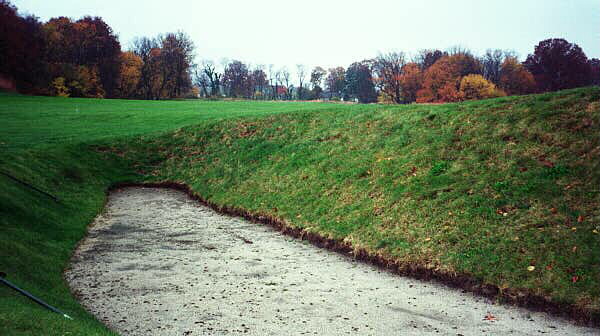
Travis believed that bunkers were hazards to be avoided. Good luck trying to reach the 6th green from here – it is still 200 yards away.
In part because of his impressive playing credentials, the Club Board decided to act upon his suggestions. Travis spent the next two years adding 50 bunkers, deepening others and re-doing all 18 greens. He also increased the length of the course and once again by 1908, this famous Long Island club was hosting another important event – the U.S. Amateur Championship. Max Behr lost in the finals, and but went on to become the Editor of Golf Illustrated and wrote extensively on the subject of golf architecture.
Since this busy decade at the start of the century, little has changed with the course, save for the (in)famous 12th hole and its three foot high mounds which were inside the green itself. Except for that one hole, the course plays as Travis intended.
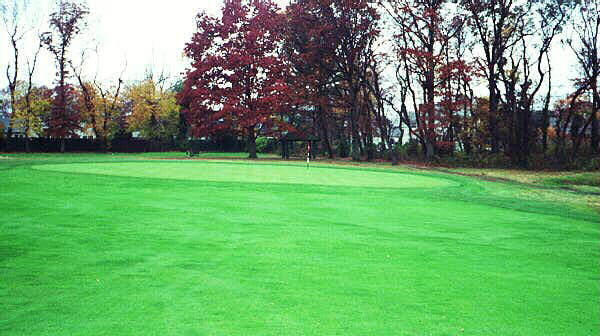
Hard to believe but the 15th green (pictured above) may rival the 4th green as the most severe on the course. Note the complete lack of artifical mounding or framing.
The joy of playing at Garden City is the complete lack of artificiality and the sense of playing a continuum of 18 holes that seem to lie effortlessly upon the ground. The distance between the green and the next tee is minimal. The holes don’t compete against nature nor among themselves but rather present a picture of pure golf.

If not for the ball washer, would you even know a tee was here? The impressive simplicity of the 7th tee box.
More holes have been singled out for inclusion in the Holes to Note than on any other course profiled on this website – the cumulative work of Emmet and Travis is that good. And what is perhaps most amazing about the design of Garden City is that the best amateurs in the country and the elder members can enjoy the course from the same single set of tee boxes.
Holes to Note
1st hole,300 yards; Right away, the golfer appreciates this course is different. The green is open on its right side and a drive long right will leave the player with a clean look down the length of the green. The rub is that the carry to the right is 225 yards over broken ground. The lesser player can go left… but is then faced with a tricky pitch over a bunker to a green that falls slightly away from that angle. Travis wrote often about the need to make a golfers think, and this hole is a perfect example.
2nd hole, 135 yards; For Emmet, this would have been the easiest hole on the course to find: it features the property’s most prominent natural attribute: an old sand quarry. The long green sits on the far side and is angled from front right to back left. In an attempt to avoid the obvious, many golfers bail long right, only to find themselves in one of several back right bunkers. In that manner, the hole bares similar strategic interest to that of a Redan but the green itself lacks the required slope to make this hole qualify as a true Redan. Nonetheless, it amply shows how much both Emmet and Travis were influenced by the great courses in the United Kingdom.
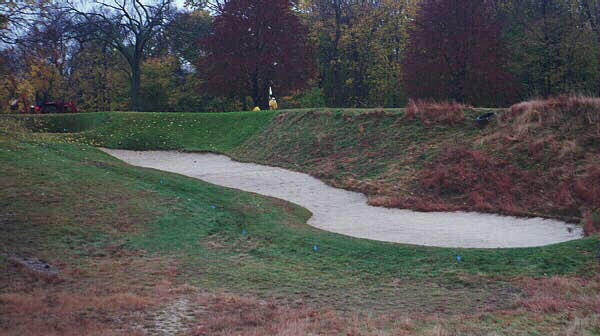
Taken from down in the quarry, this picture indicates the front right to back left orientation of the green relative to the tee. No wonder so many golfers miss the 2nd green long!
3rd hole , 405 yards; A clever hole with the fairway and green sloping in opposite directions. The hole looks innocuous from the tee as the fairway is a full 42 yards wide. There is just enough right to left slope in the fairway though to create a draw unless the alert golfer makes the adjustment. And any shot to the left side of the green, or just off it, becomes problematical as the green slopes from left to right. Many golfer leaves the hole never understanding why he dropped a shot.
4th hole, 525yards; A classic risk/reward three shot hole. A long drive which contends with the out of bounds down the right rewards the golfer with the ball on a slight up slope from which to launch a shot toward the green. A long pull though will bring an evil pit into play down the left. Assuming a good drive, the golfer must decide if a) he can reach the green, or b) he can carry the cross bunker 80 yards shy of the green, or c) he should lay back of the cross bunker and seek a flat lie for his remaining 9 iron approach. Akeyin the decision process is where is the day’s hole location, as this green contains the most interior contour on the course. Set into a hillside, the back left quadrant is raised and creates numerous difficult hole locations. Preying on the good golfer’s mind is that he is about to encounter a series of rigorous holes. Often times, he may try and force a birdie here but impetuous play is rarely rewarded at this tournament tested course.

Missing the fairway to the left does not afford the preferred angle into the 4th green.
9th hole, 325 yards; This hole is a fine example of how golf at Garden City is about angles. And often times, what seems theobviousroute proves not to be ideal. In this case, the visible flag lures golfers further right offthe tee than is wise. Not only do they increase the distance they must carry across a valley of broken ground and bunkers, but the resultingstance in thefairway will likely be from a hanging lie. The flatter part of the fairway is well left and the golfer still only has a pitch to the green. A forty yard wide crossbunker fronts the green and it has helped this modest length hole retain its challenge despite advances in technology for almost a century.
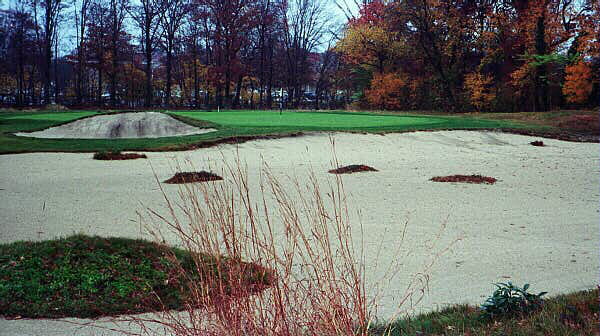
This cross bunker is just as effective today as it was 100 years ago.
10th hole, 415 yards; One of our favorite holes in golf, this hole featuresboth fairway bunkers and a green thatis titledfrom front to back and from right to left. The golfer must first try to position his ball down the left hand side of the fairway (ie flirt with the fairway bunkers) in order to better hold his approach against the right to left green slope. In a dry summer, the play is to land the approach a full 20 yards short of the green and watch as it just trickles toward the forward hole locations. Of course, the rub with all such greens is that it is better to miss it long than short – any approach shot that goeslong leaves a relatively straightforward putt, chip, or bunker shot back up the green.

These fairway bunkers guard the best angle into the green.
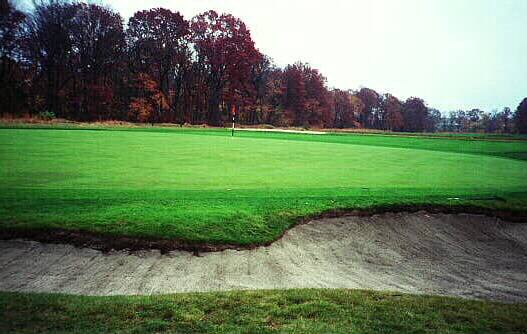
The tilt of the green from front to back and from right to left is evident in this photograph, which was taken from the behind the left of the green.
11th hole, 425 yards; Visually one of the more dramatic holes on the course, the preferred angle into the green is from the right side of the fairway. To achieve that spot, the golfer must carry a row of diagonal bunkers. Conversely, should he pull his tee ball left, the approach is likely to be blind over broken ground.
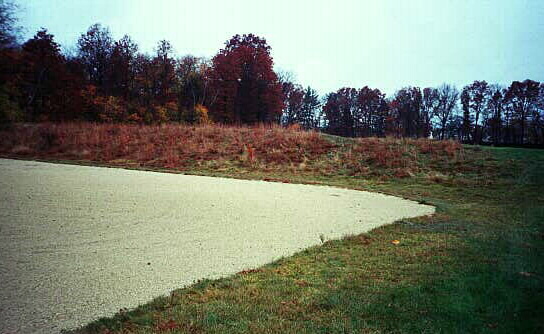
A cautious tee ball to the left must carry across broken ground that includes this bunker.
14th hole, 345 yards; Around the same time that Trent Jones altered the 12th hole, he also performed work on the 14th green. Fortunately, the Club Board hired Tom Doak as the course consultant in 1987 and by 1994, this green had been restored to its original design. Considering its length, this is a hit the green or else proposition. The small pot bunkers won’t necessarily afford the golfer the desired stance or swing, and are best to be avoided!
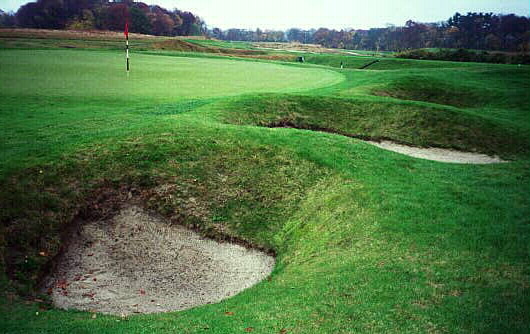
Tom Doak’s greenside bunkers replicate Travis’ s favored form of pot bunkers.

Over the 14th green is no bargain either. The mighty 15th looms in the distance.
15th hole, 445 yards; The widest fairway on the course is of small consolation to the golfer because something is going to go wrong before this – the hardest hole on the course- is finished. An immense 10 foot deep cross fairway cuts across the entire fairway at the 300 yard mark from the tee. The green itself is the picture of innocence and has no bunkers around it but is severely titled from left to right. At all costs, the golfer must leave the ball to the right and below the hole.

Job #1 is to clear this crossbunker.
16th hole, 405 yards; Ben Crenshaw’s favorite hole on the course, the configuration of the fairway again lures the golfer to head straight for the green. In reality, the better angle of approach is from the right hand side of the fairway, away from the general direction of the green. From there, the golfer has a clear look down the green and can more readily chase his approach ontoit.
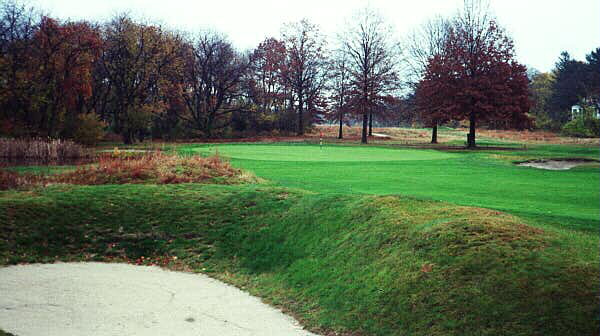
The approach from the left hand side of the fairway must carry this cluster of bunkers in the foreground, avoid the water hazard further on the left before then taking the slope down onto the green.
18th hole, 190 yards; One of the appealing features of the course is that the 1st tee leaves directly from the clubhouse and the 18th green almost appears enveloped by the clubhouse. This is sense of going andreturning is rarely found in the United States. St. Andrews is the quintessential course in this regards andspeaking of which Travis paid her Eden hole a complimentby rebuilding this green complex after it with two deep frontbunkers, a steeply pitched green from back to front and a deep pit across the back which replicates the fear of going over at St. Andrews. (Ironically, this back pit is named the Travis as it proved to be TheOld Man’sfinal undoing in a semi-final match duringthe 1908 U.S. Amateur Championship).Neither Charles Blair Macdonald nor Seth Raynor ever built a superior Eden hole, try as they might.
The start with a drivable par fourfollowed by a short iron par three is unusual andto end with two non-par four holes isequally unusual.Such pacing is a sure sign that the architects took what the lands gave them and that they never tried to make the configuration of holesconform to someimaginary ideal.
Since the late 1980s, much has been made about a return to minimalism. Hundreds of courses have been built under the banner of’following nature’s lead’and yet, other than Sand Hills, none of these courses is a match forGarden City. In fact, so many architects now claim to be minimalists that it gets confusing. However, one thingremains quiteclear: whensaid architectsuse the word minimalism, and all the good that it connotates in regards to course design, they are only hoping that they can begin to build a coursethat achieves so many of thetimeless idealsas the one found atGarden City.
The End





![The Park, West Palm (Lit 9) [2023]](https://golfclubatlas.com/wp-content/uploads/2024/12/IMG_7092-2-scaled-500x383.jpg)


